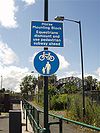Cycle Lane
| Cycle Lane | |
 | |
| A cycle lane on the B303. | |
| Pictures related to Cycle Lane View gallery (211) | |
A cycle lane is a type of cycle infrastructure. It is found on the carriageway, designating part of the carriageway for the use of cyclists. Cycle lanes come in various types: advisory, mandatory and light segregated.
Cycle lanes can also be found on shared-use footways which are segregated between cyclists and pedestrians with a painted line. Similar to the cycle lane is the cycle track.
Types of cycle lane
Advisory
Advisory cycle lanes are marked on the carriageway, and are designated by a broken white line (TSRGD diagram 1004). Cycle symbols are also available (diagrram 1057). Motorists are not advised to enter the lane unless they have a valid reason to do so.
Cycling by Design advises against advisory lanes, except where the width of an adjacent traffic lane is less than 3.25m or the cycle lane is next to areas of parking or loading.
LTN 1/20 does advise that carriageways can be functionally narrowed by removing a centre line and providing advisory lanes. Motorists can temporarily enter the advisory lane to pass other vehicles. This approach is imported from and common on quieter roads in the Netherlands where space for a cycle track is not available.
Mandatory
Mandatory cycle lanes are designated by a solid line separating them from general traffic lanes (TSRGD diagram 1049B) and upright signs (diagram 959.1). It is an offence for other traffic to enter the cycle lane, though the lane can have 'hours of operation', which allow it to be used out of hours. However, while mandatory lanes do prevent the driving of motor vehicles, it does not prevent the parking of them, which requires separate parking restrictions. Mandatory lanes themselves however do not need a Traffic Regulation Order.
Cycle lanes may also be marked on the footway, separated from pedestrians by a solid white line.
Light segregation
Light segregation is mentioned in LTN 1/20 Section 6.3.
It involves "the use of intermittent physical features placed along the inside edge of a mandatory cycle lane". Its purpose is to provide cyclists in a mandatory cycle lane with protection from general traffic. Possible features include "traffic wands, proprietary raised features constructed from PVC or recycled rubber[,] other similar objects" and planters. Light segregation has the benefit over cycle tracks as cyclists can flexibly leave and join the lanes of general traffic.
Car parking can also serve as light segreation, but a buffer should be provided to prevent 'dooring' of cyclists.
Contraflow
Cycle lanes can flow against the flow of motor traffic. These will normally be mandatory lanes, though slower or quieter roads can have an advisory lane. At either end of the street there will often be an island to give protection from turning vehicles.
Geometric features
The recommended minimum width by LTN 1/20 and Cycling by Design for a cycle lane is 2m wide, but a 1.5m lane can be used at minimum. In the Irish Cycle Manual both types are minimum of 2m wide. Anything narrower could encourage 'close passing' by motorists.
High volume cycle facilities
Where higher volumes of cyclists are expected, some authorities build cycle facilities that offer a higher level of provision, for example Cycle Superhighways in London. These range from cycle lanes marked on the carriageway to the more recent segregated two-way facilities such as those built in Farringdon Street and across Blackfriars Bridge.
Other authorities have built segregated stepped tracks where the cycleway is separated from the carriageway by a half-height kerb, and is separated from the footway by a second half-height kerb.




